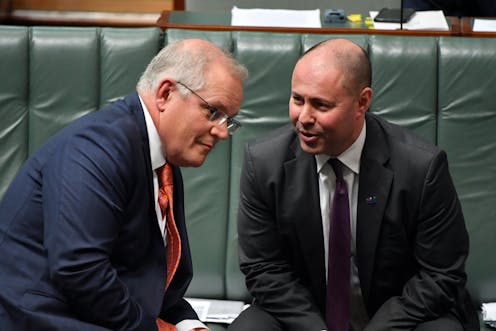Coalition gains in Newspoll after budget; Trump falls further behind Biden
- Written by Adrian Beaumont, Honorary Associate, School of Mathematics and Statistics, University of Melbourne

This week’s Newspoll[1], conducted October 8–10 from a sample of 1,527 voters, gave the Coalition a 52–48% lead over Labor in the two-party preferred question, a one-point gain for the Coalition since the previous Newspoll three weeks ago.
Primary votes were 44% Coalition (up one), 34% Labor (steady), 11% Greens (down one) and 3% One Nation (steady).
Prime Minister Scott Morrison remained very popular: 65% were satisfied with his performance and 31% were dissatisfied, for a net approval of +34. These figures are unchanged from the last poll.
Opposition Leader Anthony Albanese’s net approval slid three percentage points to -4. His net approval is down six points since late August. Morrison led as better PM by 57-28% (compared to 59-27% three weeks ago).
Newspoll[2] asks three questions after each budget: whether the budget was good or bad for the economy, whether it was good or bad for you personally, and whether the opposition would have delivered a better budget.
On the economy, 42% said the budget was good and 20% bad. When it came to people’s personal fortunes, 26% said they would be better off after the budget, compared to 23% who said worse off. By 49-33%, respondents said Labor would not have delivered a better budget.
Analyst Kevin Bonham tweeted a graph showing this budget performed well compared to historical budgets. The 16-point deficit for the question of whether Labor would have delivered a better budget is the worst for an opposition since 2009.
The one-point gain for the Coalition on people’s voting intentions is also consistent with a well-received budget.
Australian state polls: Victoria and WA
A Victorian Morgan SMS poll[3], conducted September 29-30 from a sample of 2,220 voters, gave Labor a 51.5-48.5% lead over the Coalition, unchanged from mid-September.
Primary votes were 39% Labor (up two), 39.5% Coalition (up one) and 10% Greens (down two). Morgan’s SMS polls have been unreliable in the past.
In a forced choice, Premier Daniel Andrews had a 61-39% approval rating, down from 70-30% in early September.
Three weeks ago, Newspoll[4] gave Andrews a 62-35% approval rating (compared to 57-37% in late July).
An Utting Research[5] poll of five Western Australian marginal seats showed an average swing to Labor of 16%. In Liberal leader Liza Harvey’s Scarborough seat, the result was 66-34% to Labor.
Labor had a big victory at the March 2017[6] state election, and this poll suggests a Liberal wipe-out at the next election, due in March 2021.
Biden’s national lead over Trump exceeds ten points
In the FiveThirtyEight national poll aggregate[7], Democratic presidential nominee Joe Biden now leads President Donald Trump by 10.4% (52.2–41.9%). It’s somewhat closer in the key swing states, with Biden leading by 8.0% in Michigan, 7.3% in Pennsylvania, 7.2% in Wisconsin, 4.5% in Florida and 3.9% in Arizona.
Since my article[8] about Trump’s coronavirus infection and the first presidential debate, Biden’s national lead has increased by 1.4%.
With Pennsylvania and Wisconsin now polling very closely, both can be seen as “tipping point” states. Previously, Pennsylvania had been better for Trump than Wisconsin.
The gap in Trump’s favour between the national vote and the tipping-point states of Wisconsin and Pennsylvania has increased from 2.4% to 3.2%. If Trump were within five points nationally, this election would be highly competitive. But this difference isn’t going to matter with Biden up ten points nationally.
CNN analyst Harry Enten[9] says Biden is polling better than any challenger against an incumbent president since 1936, when scientific polling started.
US polls include undecided voters, so it is hard for candidates to reach 50%. In 2016, Democratic candidate Hillary Clinton never reached that mark in polls, and Trump was able to win far more of the late deciders.
The FiveThirtyEight forecast[10] gives Trump a 14% chance to win, down from 17% last week. Trump has just a 6% chance to win the popular vote.
The Senate forecast[11] gives Democrats a 72% chance to win the Senate, up from 70% last Wednesday. The most likely Senate outcome is still a narrow 51-49 Democratic majority.
References
- ^ Newspoll (cdn.newsapi.com.au)
- ^ Newspoll (cdn.newsapi.com.au)
- ^ Morgan SMS poll (www.roymorgan.com)
- ^ Newspoll (www.pollbludger.net)
- ^ Utting Research (www.pollbludger.net)
- ^ March 2017 (en.wikipedia.org)
- ^ national poll aggregate (projects.fivethirtyeight.com)
- ^ article (theconversation.com)
- ^ Harry Enten (edition.cnn.com)
- ^ FiveThirtyEight forecast (projects.fivethirtyeight.com)
- ^ Senate forecast (projects.fivethirtyeight.com)













